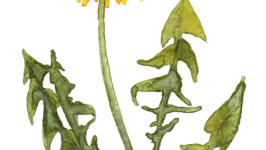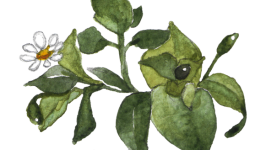The Fruit Forager’s Companion
Yes, I harvest wild black raspberries from my secret roadside patch each summer. They were my one and only coveted treasure in the world of foraged fruits. But Sara Bir, chef and author of the newly released Fruit Forager’s Companion, opened my eyes (and nose and taste buds) to a host of less-known wild fruits, many that I previously rushed past while hiking, driving or biking. After reading her book, I now spontaneously stop to gather elderberries and red flower sumac, to check on a nearby grove of pawpaws to see if the fruits are ripe, to inquire about an abandoned apple orchard and even to plant my own ground cherries to harvest.
In her book’s introduction, Bir confesses: “I am not a foraging expert, and I am not a botanist; I’m a physically restless chef who likes plants.” Restless, indeed.
Bir grew up in Marietta, Ohio, and left with plans to never return. While away, she studied at the Culinary Institute of America in New York City, contributed to Paste Magazine and worked several culinary-related jobs in Portland, Oregon, and San Francisco. But eventually she grew disenchanted with the West Coast and was stirred to return to her hometown. Once back, Bir began exploring nearby woods with a new set of eyes for Appalachia’s “wonders on a smaller scale” and a new definition of “what was epic.” Pawpaws were her introduction to foraged foods, and her repertoire began to expand.
In this book that’s part memoir and part guide, Bir features 40 fruits from across the country. Each fruit is beautifully illustrated and photographed. Plus, Bir adds personal anecdotes, botanical notes, harvesting tips, culinary suggestions and recipes for each (see sidebar for Elderberry Kir Royale recipe). A handful of the tropical fruits like pomegranates and oranges you won’t find growing in Ohio, but there’s still plenty of cold-hardy varieties to add adventure to your foraging treks and cooking.
Bir completes the book with 100 foraged fruit recipes ranging from wild cherry bounce (liqueur) to crab apple chutney to pawpaw lemon curd. As a seasoned chef, Bir has great respect for the fruit ingredients she gathers and she removes the culinary hurdles for readers by offering proven recipes. She even encourages readers to experiment and adapt the recipes, as foraged fruits often vary by plant and location. Bir’s fruit shrub syrup, spicebush-sumac rub and jam combos are definitely recipes I’ll try in my kitchen.
Bir peppers the guide with thoughtful essays and valuable lessons on topics like invasive plants, pectin’s role in making preserves and tips for labeling canned goods. She even covers “Honorable Mention” fruits like ginkgo and kousa dogwood and “Look But Don’t Eat” fruits like castor bean and honeysuckle.
As a modern-day food forager, Bir encourages readers to scour “a new wilderness, the place where the natural world and the developed world meet.” She points readers to unexpected foraging sources such as a neighbor’s overabundant fruit trees (with permission), a co-worker’s wooded property, the fringes of commercial parking lots, roadside patches, parks and hiking trails.
Best of all, Bir brings a fresh perspective to the definition of foraging. Much like my yoga instructor, she refers to her foraging as a “practice” or “art.” She encourages readers to reconnect with nature This excerpt is adapted from Sara Bir’s book The Fruit Forager’s Companion: Ferments, Desserts, Main Dishes, and More from Your Neighborhood and Beyond (Chelsea Green, 2018) and is printed with permission from the publisher. and believes once the foraging mindset takes control, a new culinary world hiding in plain sight will reveal itself. Whether you’re a foraging foodie or not, I recommend The Fruit Forager’s Companion to take cooking or foraging experiences to a new level.
This excerpt is adapted from Sara Bir’s book The Fruit Forager’s Companion: Ferments, Desserts, Main Dishes, and More from Your Neighborhood and Beyond (Chelsea Green, 2018) and is printed with permission from the publisher.







